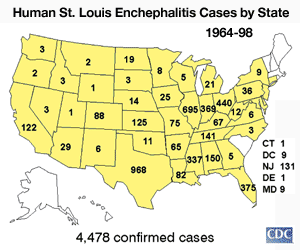St Louis Encephalitis

Clinical Features:
• Aseptic meningitis or encephalitis.
• The majority of infections are subclinical or result in mild illness
Etiologic Agent:
• St. Louis encephalitis virus - flavivirus related to Japanese encephalitis virus
Sequelae:
• Hospitalization for CNS infection - 95% of recognized cases.
Costs:
• National expenditures for mosquito control activities - $150 million
• SLE surveillance and control activities 0-70% of total; (varies by state)
Transmission:
• Mosquito Borne
• Specific mosquito vectors vary regionally
• Gulf Coast, Ohio and Mississippi Valley: (Culex pipiens, Cx. quinquefasciatus)
• Florida: Cx. nigripalpus
• Western States: Cx. tarsalis
Risk Groups:
• Elderly - biological risk factor
• Low SES areas - environmental risk factor
• Outdoor occupation - exposure risk factor
Surveillance:
• Mosquito Control Districts
• Active surveillance in collaboration with state and local health departments
Trends:
• Largest outbreaks in 15 years occurred in 1990
• Urban transmission in west first recognized in 1987
• Deterioration of inner cities global warming may increase vector abundance and transmission
• Unpredictable and intermittent occurrences of outbreaks
• Multiple environmental, biological and social factors contributing to disease occurrence
• Virus maintenance and overwintering cycle
• Develop more effective disease prevention and treatment
Questions & Answers About St. Louis Encephalitis
Q. Is there a vaccine against St. Louis encephalitis?
A. No.
Q. Where does St. Louis encephalitis occur?
A. See map: St. Louis encephalitis outbreaks can occur throughout most of the United States. The last major epidemic of St. Louis encephalitis occurred in the Midwest from 1974-1977. During that outbreak, over 2,500 cases in 35 states were reported to the CDC. Currently, outbreaks of St. Louis encephalitis have been limited in size (usually <30 cases), although the potential still exists for epidemic St. Louis encephalitis. The most recent outbreak of St. Louis encephalitis occurred in New Orleans, Louisiana in 1999, with 20 reported cases.
Q. Who is at risk for getting St. Louis encephalitis?
A. All residents of areas where active cases have been identified are at risk of getting St. Louis encephalitis.
Q. Is the disease seasonal in its occurrence?
A. In temperate areas of the United States, St. Louis encephalitis cases occur primarily in the late summer or early fall. In the southern United States where the climate is milder St. Louis encephalitis can occur year round.
Q. How is St. Louis encephalitis treated?
A. There is no specific therapy. Intensive supportive therapy is indicated.
Q. How many cases of St. Louis encephalitis occur in the U.S.?
A. Since 1964 there have been 4,478 reported human cases of St. Louis encephalitis, with an average of 128 cases reported annually.
Q. What is the mortality rate of St. Louis encephalitis?
A. Case-fatality rates range from 3% to 30% (higher in the elderly).
Q. What is the incubation period for St. Louis encephalitis?
A. Usually 5 to 15 days.
Q. What are the symptoms of St. Louis encephalitis?
A. Mild infections occur without apparent symptoms other than fever with headache. More severe infection is marked by headache, high fever, neck stiffness, stupor, disorientation, coma, tremors, occasional convulsions (especially in infants) and spastic (but rarely flaccid) paralysis.
Q. Could you get St. Louis encephalitis directly from birds or from insects other than mosquitoes?
A. No. Only infected mosquitoes can transmit St. Louis encephalitis virus.
Q. Could you get the St. Louis encephalitis from another person?
A. No, St. Louis encephalitis virus is NOT transmitted from person-to-person. For example, you cannot get the virus from touching or kissing a person who has the disease, or from a health care worker who has treated someone with the disease.
Q. What is the basic transmission cycle?
A. Mosquitoes become infected by feeding on birds infected with the St. Louis encephalitis virus. Infected mosquitoes then transmit the St. Louis encephalitis virus to humans and animals during the feeding process. The St. Louis Encephalitis virus grows both in the infected mosquito and the infected bird, but does not make either one sick. See Figure.
Q. How do people get St. Louis encephalitis?
A. By the bite of a mosquito (primarily the Culex species) that become infected with St. Louis encephalitis virus (a flavivirus antigenically related to Japanese encephalitis virus).
Trends:
• Largest outbreaks in 15 years occurred in 1990
• Urban transmission in west first recognized in 1987
• Deterioration of inner cities global warming may increase vector abundance and transmission
• Unpredictable and intermittent occurrences of outbreaks
• Multiple environmental, biological and social factors contributing to disease occurrence
• Virus maintenance and overwintering cycle
• Develop more effective disease prevention and treatment
Surveillance:
• Mosquito Control Districts
• Active surveillance in collaboration with state and local health departments
Risk Groups:
• Elderly - biological risk factor
• Low SES areas - environmental risk factor
• Outdoor occupation - exposure risk factor
Transmission:
• Mosquito Borne
• Specific mosquito vectors vary regionally
• Gulf Coast, Ohio and Mississippi Valley: (Culex pipiens, Cx. quinquefasciatus)
• Florida: Cx. nigripalpus
• Western States: Cx. tarsalis
Costs:
• National expenditures for mosquito control activities - $150 million
• SLE surveillance and control activities 0-70% of total; (varies by state)
Sequelae:
• Hospitalization for CNS infection - 95% of recognized cases.
Etiologic Agent:
• St. Louis encephalitis virus - flavivirus related to Japanese encephalitis virus
Clinical Features:
• Aseptic meningitis or encephalitis.
• The majority of infections are subclinical or result in mild illness
